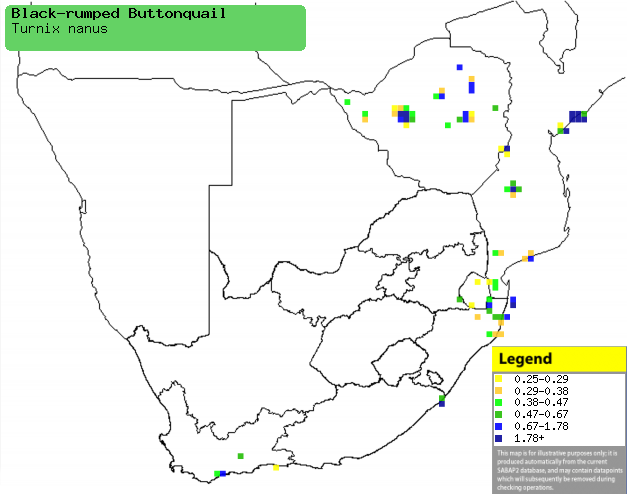|
Turnix nanus (Black-rumped
buttonquail)
Swartrugkwarteltjie [Afrikaans]; Turnix nain [French]
Life
> Eukaryotes >
Opisthokonta
> Metazoa (animals) >
Bilateria >
Deuterostomia > Chordata >
Craniata > Vertebrata (vertebrates) > Gnathostomata (jawed
vertebrates) > Teleostomi (teleost fish) > Osteichthyes (bony fish) > Class:
Sarcopterygii (lobe-finned
fish) > Stegocephalia (terrestrial
vertebrates) > Tetrapoda
(four-legged vertebrates) > Reptiliomorpha > Amniota >
Reptilia (reptiles) >
Romeriida > Diapsida > Archosauromorpha > Archosauria >
Dinosauria
(dinosaurs) > Saurischia > Theropoda (bipedal predatory dinosaurs) >
Coelurosauria > Maniraptora > Aves
(birds) > Order: Turniciformes > Family: Turnicidae
Distribution and habitat
Occurs patchily from Cameroon south through southern DRC,
Angola and Zambia to southern Africa. Here it is localised and uncommon in
central Zimbabwe, Mozambique, Swaziland, Limpopo Province and eastern KwaZulu-Natal,
with isolated populations in the Western and Eastern Cape. It generally prefers
short grassland with patches of bare clay ground, especially with Teringbossie (Thesium
brevibarbatum), Red grass (Themeda triandra) and other grasses. It
may also move into open savanna, cultivated fields and marshy ground at the edge
of irrigated sugar cane fields.
|
 |
|
Distribution of Black-rumped buttonquail in southern Africa,
based on statistical smoothing of the records from first SA Bird Atlas
Project (©
Animal Demography unit, University of
Cape Town; smoothing by Birgit Erni and Francesca Little). Colours range
from dark blue (most common) through to yellow (least common).
See here for the latest distribution
from the SABAP2. |
Movements and migrations
Thought to be a partial migrant, as it is a
seasonal visitor to the Mashonaland plateau of Zimbabwe during
summer rains, while elsewhere it is nomadic.
Food
Its diet consists mainly of insects and their larvae, other
invertebrates and seeds.
Breeding
- Polyandrous, territorial solitary nester.
- The nest is built mainly by the female. consisting of a shallow scrape
in the ground, thinly lined with grass and typically placed in or between
grass tufts.
- Egg-laying season is from September-March, peaking from December-March.
- It lays 2-4 eggs, which are incubated solely by the female for about
12-14 days.
Threats
Endangered in South Africa due to overgrazing,
commercial afforestation, too frequent burning, ploughing, agriculture and human
settlements.
References
-
Hockey PAR, Dean WRJ and Ryan PG 2005. Roberts
- Birds of southern Africa, VIIth ed. The Trustees of the John Voelcker
Bird Book Fund, Cape Town.
|
